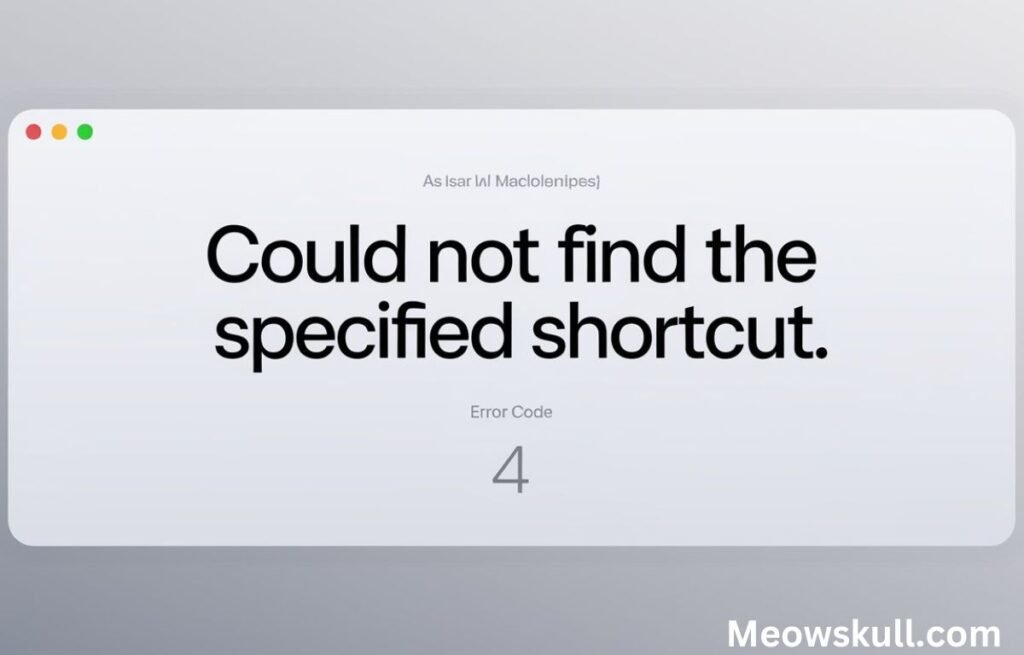errordomain=nscocoaerrordomain&errormessage=could not find the specified shortcut.&errorcode=4 is a common error domain in Apple development. It is used to group errors that happen in macOS, iOS, and other Apple platforms. When developers work on apps, they may encounter errors from this domain. These errors help identify issues related to file handling, shortcuts, and more. Understanding this domain is key for fixing bugs in Apple apps.
When an error occurs in errordomain=nscocoaerrordomain&errormessage=could not find the specified shortcut.&errorcode=4, it often comes with a code. This code helps developers know what went wrong. For example, error code 4 means there is a problem with finding a specific shortcut. By knowing the error code, developers can quickly find a solution. Learning how to deal with these errors can improve app performance.
Understanding Error Code 4
Error Code 4 in the NSCocoaErrorDomain means the system couldn’t find a shortcut that it was looking for. This error happens when an app tries to access a specific shortcut that no longer exists or was never set up. It can cause a part of the app to stop working properly. Developers need to identify the missing shortcut to fix the issue.
The error message helps point out the problem so it can be solved quickly. It’s important to check if the shortcut was deleted, renamed, or never created. Once the source is found, the developer can restore or recreate the shortcut. This process helps the app run smoothly again without further issues.
Also Read: https:// www.mediafire.com/file/g181swd6juswp19/launch_lotf2_game.zip/file
Role of Shortcuts in macOS and iOS

Shortcuts in macOS and iOS allow users to quickly perform tasks with simple commands. These shortcuts help save time by automating common actions, like opening apps or sending messages. Users can create their own shortcuts or use default ones provided by the system. Shortcuts improve the overall experience by making tasks easier and faster to complete.
For developers, properly managing shortcuts is crucial to ensuring their app functions smoothly. If a shortcut is missing or broken, users may face issues with the app’s performance. This can lead to errors like errordomain=nscocoaerrordomain&errormessage=could not find the specified shortcut.&errorcode=4. Understanding the role of shortcuts helps developers prevent these problems and keep their apps running efficiently.
Common Triggers for This Error
There are several reasons why Error Code 4 occurs in the errordomain=nscocoaerrordomain&errormessage=could not find the specified shortcut.&errorcode=4. One common trigger is when a shortcut gets deleted or moved, but the app still tries to use it. If the app cannot find the shortcut, it results in this error. Another reason is when a shortcut has never been properly set up, and the app expects it to be there.
Sometimes, updates to the operating system or the app can break shortcuts. This happens when the app doesn’t update its shortcut paths correctly after a change. Misconfigurations during app installation can also cause this error. Knowing these triggers helps developers understand what might have gone wrong.
Troubleshooting the Shortcut Error
To fix Error Code 4, the first step is to check if the shortcut still exists. Developers should verify if the shortcut was accidentally deleted or moved. If it’s missing, they can recreate the shortcut or update the app to reflect the correct path. This often resolves the issue quickly.
Another way to troubleshoot is by using Xcode or other Apple development tools to debug the app. These tools help identify where the app is trying to access the missing shortcut. Developers can also look at error logs to find more details about the problem. Following these steps helps ensure the app functions properly again.
Also Read: Exploring https gay lordtexan. boomerecommerce. com
Handling NSCocoaErrorDomain Programmatically

When working with errordomain=nscocoaerrordomain&errormessage=could not find the specified shortcut.&errorcode=4, developers need to handle them in the code. Using try-catch blocks in Swift or Objective-C can help catch the error before it crashes the app. Once the error is caught, the app can show a message to the user or attempt to fix the problem automatically.
Developers can also log these errors for further analysis. This helps track when and where the error occurs, making it easier to find a permanent solution. By managing these errors programmatically, developers ensure their apps run smoothly, even when things go wrong. It’s important to have a good error-handling strategy in place to improve app reliability.
User Impact of Shortcut Errors
When an app encounters Error Code 4, it can disrupt the user experience. If a shortcut cannot be found, certain features of the app may not work. This can frustrate users, especially if the missing shortcut is crucial to the app’s functionality. For example, users might be unable to open files or trigger specific actions in the app.
A broken shortcut can make the app feel unreliable, causing users to lose trust in the product. In some cases, users may not understand why the error is happening, leading to confusion. Developers need to fix these issues quickly to maintain a smooth and enjoyable user experience. Clear communication and quick updates help prevent long-term negative impacts.
Developer Best Practices
To avoid errors like Error Code 4, developers should follow best practices when working with shortcuts. First, they should ensure that all shortcuts are correctly set up during the development process. Regular testing should be done to confirm that shortcuts are functioning as expected, especially after updates to the app or the operating system.
It’s also important to handle shortcuts dynamically, meaning the app should be able to detect if a shortcut is missing and provide alternatives. Providing clear error messages to users and logging issues for developers to review helps in quick problem-solving. By following these practices, developers can reduce the chances of shortcut-related errors in their apps.
Also Read: Understanding http://anthony.myimergefinancial.com
Related errordomain=nscocoaerrordomain&errormessage=could not find the specified shortcut.&errorcode=4

Apart from Error Code 4, there are other common errors in the NSCocoaErrorDomain that developers may encounter. For instance, Error Code 260 occurs when a file cannot be found, which is similar to missing shortcuts but relates to file handling. Another error, Error Code 516, happens when there’s an attempt to overwrite a file that already exists.
Understanding these related errors helps developers prepare for various issues that might come up during app development. Each error code provides specific clues to what went wrong. Being familiar with these error codes allows developers to address different problems efficiently, improving overall app quality.
Conclusion
In summary, errordomain=nscocoaerrordomain&errormessage=could not find the specified shortcut.&errorcode=4 indicates that a specific shortcut could not be found. Understanding this error helps developers quickly identify and fix issues related to missing or misconfigured shortcuts. By following best practices for managing shortcuts and handling errors, developers can enhance app reliability and user experience.
Addressing these errors promptly and effectively minimizes disruptions and maintains user trust. Regular testing and clear error management are crucial in preventing similar issues in the future. With the right approach, developers can ensure their apps run smoothly and deliver a positive experience for users.
FAQs
What does mean errordomain=nscocoaerrordomain&errormessage=could not find the specified shortcut.&errorcode=4?
errordomain=nscocoaerrordomain&errormessage=could not find the specified shortcut.&errorcode=4 indicates that a specific shortcut could not be found. This error usually occurs when an app tries to access a shortcut that has been deleted, moved, or was never created. It helps developers understand that something is wrong with the shortcut configuration in their app.
How to fix errordomain=nscocoaerrordomain&errormessage=could not find the specified shortcut.&errorcode=4?
To fix this error, first, check if the shortcut still exists and is correctly set up. If it’s missing, you may need to recreate or restore it. Using debugging tools like Xcode can also help you locate where the app is trying to access the shortcut. Updating the app or correcting the shortcut path in the code can resolve the issue.
Why is Error Code 4 affecting my app’s functionality?
Error Code 4 affects your app’s functionality because the app relies on the missing shortcut to perform certain actions. When the shortcut cannot be found, those actions fail, potentially causing parts of the app to stop working. This disrupts the user experience and can lead to frustration if not addressed promptly.
Can Error Code 4 be caused by updates to the app or operating system?
Yes, Error Code 4 can be caused by updates to the app or the operating system. Sometimes, these updates can change how shortcuts are handled or how they are accessed, leading to broken paths or missing shortcuts. Ensuring that shortcuts are properly updated or recreated after such changes can help prevent this error.
How can I prevent Error Code 4 from occurring in my app?
To prevent Error Code 4, make sure to properly set up and manage shortcuts during development. Regularly test your app to ensure shortcuts are functioning correctly, especially after updates. Implement error-handling routines in your code to detect and manage missing shortcuts effectively. Keeping your app and shortcuts well-maintained will minimize the chance of encountering this error.

As a seasoned contributor to “Meowskull”, Rosalie combines her linguistic prowess with a keen understanding of various topics, ensuring a delightful and informative reading experience. Her articles effortlessly blend clarity, creativity, and a touch of elegance, making language exploration an exciting journey for readers.